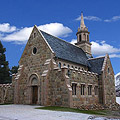Masonry Consolidation and Stabilisation
Many of Scotland’s most significant buildings and monuments are wholly or partially ruinous. These historic structures are often exposed to the elements and therefore vulnerable to increased material deterioration, often resulting in loss of original fabric through structural failure.
The conservation and repair of these buildings can pose the project team with a series of challenges, from emergency shoring scaffolding through to appropriate finishing techniques to minimise the effects of unidirectional weathering and exposure.
LTM have worked on an extensive range of ruinous buildings throughout Scotland, many in extremely remote and difficult locations, requiring access by boat, quad bike and helicopter to transport labour and materials to site.
Consolidation and repair techniques may include structural steel-ties (normally as a last resort!), wall core gravity grouting and soft capping (clay and turf) exposed wallheads. Such buildings often require specialist input to preserve these buildings ‘as found’, ensuring minimal intervention and retention of authenticity.
Featured Masonry Consolidation and Stabilisation Case Studies

Private Chapel - Scottish Highlands
This project was one of the most exciting and unique for LTM’s stonemasons. It involved the unprecedented opportunity to combine traditional craft skills and building materials with modern construction technology ...

Dunnottar Castle - Stonehaven
Dunnottar Castle is one of the most dramatic historic sites in Scotland. It was originally an ancient Pictish fortress (5000 BC to 700 AD): “dun” is Pictish for hill fort or place of strength. The site is also believed to be an early Christian site founded by St Ninian in the 5th century ...

Kilmorie Chapel - Argyll
Kilmorie Chapel is a Scheduled Ancient Monument dating from the late medieval period, possibly 8th - 10th century. The church is located between the Old and New Castle Lachlan and is the traditional burying grounds of the chiefs of Clan Maclachlan ...